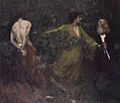
Original file (1,030 × 882 pixels, file size: 120 KB, MIME type: image/jpeg)
| This is a file from the Wikimedia Commons. Information from its description page there is shown below. Commons is a freely licensed media file repository. You can help. |
Summary
| Károly Ferenczy: Isaac's Sacrifice
( |
||||||||||||||||||||||||
|---|---|---|---|---|---|---|---|---|---|---|---|---|---|---|---|---|---|---|---|---|---|---|---|---|
| Artist |
artist QS:P170,Q701504 |
|||||||||||||||||||||||
| Title |
Isaac's Sacrifice |
|||||||||||||||||||||||
| Object type |
painting object_type QS:P31,Q3305213 |
|||||||||||||||||||||||
| Date |
1901 date QS:P571,+1901-00-00T00:00:00Z/9 |
|||||||||||||||||||||||
| Medium |
oil on canvas medium QS:P186,Q296955;P186,Q12321255,P518,Q861259 |
|||||||||||||||||||||||
| Dimensions |
height: 139 cm (54.7 in); width: 163 cm (64.1 in) dimensions QS:P2048,139U174728 dimensions QS:P2049,163U174728 |
|||||||||||||||||||||||
| Collection |
institution QS:P195,Q252071 |
|||||||||||||||||||||||
| Source/Photographer |
Fine Arts in Hungary: |
|||||||||||||||||||||||
| Permission (Reusing this file) |
|
|||||||||||||||||||||||
File history
Click on a date/time to view the file as it appeared at that time.
| Date/Time | Thumbnail | Dimensions | User | Comment | |
|---|---|---|---|---|---|
| current | 23:01, 7 December 2008 |  | 1,030 × 882 (120 KB) | Jedudedek | {{Information |Description= |Source=internet |Date= |Author= |Permission=Reproduction of a painting that is in the public domain because of its age |other_versions= }} {{PD-Art}} Category:Károly Ferenczy |
File usage
The following 2 pages use this file:
Global file usage
The following other wikis use this file:
- Usage on es.wiki.x.io
- Usage on hy.wiki.x.io
- Usage on ro.wiki.x.io
Metadata
This file contains additional information, probably added from the digital camera or scanner used to create or digitize it.
If the file has been modified from its original state, some details may not fully reflect the modified file.
| JPEG file comment | FERENCZY Károly
(1862, Bécs - 1917, Budapest) Izsák feláldozása 1901 Olaj, vászon, 139 x 163 cm Magyar Nemzeti Galéria, Budapest A festmény határmezsgyén áll Ferenczy két alkotói korszaka között. A három évvel korábban készült Háromkirályokkal összehasonlítva felfedezhetõk a rövidesen bekövetkezõ változás elõjelei. A nappalra éjszakát, éjszakára nappalt hozó órák különös hangulatát, valószerûtlen sejtelmességét fokozatosan felváltja Ferenczy képein a nappal józansága, majd a verõfény. Ezzel együtt jár a motívumok konkrétsága, reális ábrázolása. A Háromkirályok nemcsak tárgyának bibliai eredete miatt kínálkozik összvetésre, a két jelenet szinte azonos erdei környezete is indokolja azt. Angyal jelenik meg Ábrahámnak, aki Istenhez való hûségét fia, Izsák feláldozásával akarja bizonyítani. Égi jelentés állítja meg az apát tette elkövetésében, csoda történik. Ferenczy általában nem témához keresett környezetet a nagybányai tájban. Épp ellenkezõleg, a természet élménye sugallta legtöbbször mûvei tárgyát. Az Ábrahám áldozata megfestésekor már nem az erdõ misztikus hangulata, hanem eleven pompája ragadta meg képzeletét. A Háromkirályok címû festményen a sûrû, fény nem járta lombozat mesebeli lovasok mögött zárul össze, s az erdõ hûvös mélye elfoglalja a képfelület felét. Lényegi változás ehhez képet, hogy Ábrahám áldozatának megfestésekor az árnyakat elûzõ nappali fényben az erdõ a maga tárgyias valóságában jelenik meg, s, hogy a rozsdabarna nagybányai talaj fölött kibomló növényzet csak a helyszín érzékeltetéséhez feltétlenül szükséges mértékben van jelen. A lombok közül elõlépõ Angyal nem annyira égi jelenés, mint inkább földi karakterû, erõteljes, szép fiatal férfi - noha gesztusa fenséges, komoly és parancsoló. A három lovassal összehasonlítva Ábrahám, Izsák és az Angyal alakja léptékben erõsen megnövekedett. A drámai szituáció hangsúlya érdekben a környezet leszûkült, a természet háttérbe szorul, s elsõsorban esztétikum hordozója. A cselekvõ, dinamikus angyal figuráját két passzív szereplõ fogja közre. Egybevág ez a formai szerkezet a Háromkirályok színszerkesztésével, ahol a hideg színvilág közepérõl parázslik fel a vörös. FERENCZY, Károly (1862, Bécs - 1917, Budapest) Isaac's Sacrifice (Sacrifice of Abraham) 1901 Oil on canvas, 139 x 163 cm Hungarian National Gallery, Budapest The picture is on the borderline between Ferenczy's two artistic periods. If one compares the picture with "The Three Magi", signs of change soon to follow are evident. The peculiar atmosphere of nights and days are gradually substituted by the sobriety of daylight, then the bright sunshine, which is accompanied by the concreteness and realistic portrayal of motifs. Comparison with "The Three Magi" is fairly obvious, not just because of the biblical origin of the subject matter, but because of the presence of the forest, too. An angel appears to Abraham who wants to prove his faith in God by sacrificing Isaac, his son. A sign from heaven prevents the father from carrying out his plan. Ferenczy never tried to find setting for his subject matters around Nagybánya, it was the other way around. When he was painting "Abraham's Sacrifice", it was not the mystic atmosphere of the forest but its lively pomp which inspired him. In "The Three Magi", branches of trees devoid of light lock up behind the mythical riders, and the cool depth of the forest fills half of the picture. A further substantial difference is that the forest in "Abraham's Sacrifice" appears in its objectiveness in the sunshine and plants are present as long as they are essential to indicate location. The Angel stepping out of the forest is not so much of a heavenly appearance, he is rather a worldly man, young and attractive, although his gesture is majectic, serious and authoratitive.The figures of Abraham, Isaac and the Angel are somewhat oversize as compared with those of the three riders. As a result of the dramatic situation, the setting has become limited, nature is pushed back into the background and is a carrier of esthetics. The dynamic figure of the Angel is surrounded by the two passive figures. This form of composition matches the arrangement of colours in "The Three Magi", where red is glowing in the middle of cold colours. Type: religious Time-line: 1901-1925 Form: painting |
|---|

